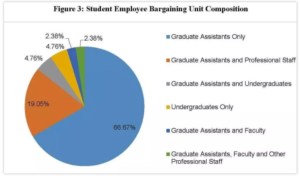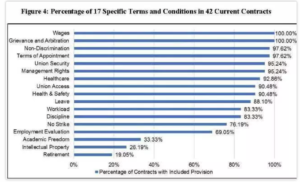December 11, 2019
Research on Graduate Assistants and Right to Unionize Challenges NLRB Proposed Rule
By William Herbert and Joseph van der Naald
This originally appeared at Labor Online, the blog of the Labor and Working Class History Association website.
On November 20, 2019, National Center for the Study of Collective Bargaining in Higher Education and the Professions, Hunter College, City University of New York submitted comments to the National Labor Relations Board (NLRB) in response to its proposed rule to exclude graduate assistants and student employees from coverage under the National Labor Relations Act (NLRA). The comments include history, empirical evidence, and legal precedent.
This year marks the first half-century of unionization and collective bargaining involving student employees in higher education in the United States. In 1969, the New York State Public Employment Relations Board certified a union to represent a bargaining unit at the City University of New York (CUNY) that included teaching assistants, research assistants, and research associates.
Union representation of CUNY graduate teaching and research assistants has continued until the present day in a bargaining unit that includes faculty and other professionals. Similarly, teaching assistants at Rutgers University have been continuously represented in a bargaining unit with faculty since the early 1970s. The longevity and stability of the combined units at the CUNY and Rutgers University undermine claims by other institutions that the unionization of graduate assistants will impair faculty-graduate student relations.
In the same year as the original CUNY certification, a collective bargaining relationship for teaching assistants only was established at the University of Wisconsin-Madison. Negotiations between the university and the Teachers’ Assistants Association led to a written contract, signed on April 17, 1970, that set the terms of employment for approximately 1,900 teaching assistants. The earliest known certification of a union to represent student food service workers on campus was issued on April 28, 1970 to AFSCME Council 75 for a bargaining unit at the University of Oregon.
Over the next five decades, a large body of state and Canadian provincial legal precedent developed finding that graduate assistants and other student employees had the right to unionize and engage in collective bargaining at public institutions. In Florida and Missouri, state appellate courts have ruled that graduate assistants have a state constitutional right to organize, underscoring the importance of state constitutions as sources of labor rights.
In contrast, the NLRB has flip flopped over the decades concerning whether the same rights exist under federal labor law. The last NLRB ruling was in the Columbia University decision, which found graduate and undergraduate assistants had the right to organize. During the NLRB’s decisional oscillation over the years, it has largely ignored public sector history, precedent, and collective bargaining experience at public colleges and universities.
The purpose of the NLRB’s proposed rule is to overturn the Columbia University decision through regulation rather than adjudication. If the rule is adopted more than 81,000 graduate assistants at over 500 private institutions will be excluded from NLRA coverage, and it would constitute the largest per se exclusion of an occupation since Taft-Hartley.
In the National Center’s comments we presented data from the United States Department of Labor Bureau of Labor Statistics and the United States Department of Education’s National Center for Education Statistics, demonstrating that the NLRB’s proposed rule would exclude from NLRA coverage at least 81,390 graduate assistants working at 518 private institutions in occupations recognized by those other federal agencies, and treated as distinct from the classification of graduate student.
Our comments examined the terms of 42 current collective bargaining agreements involving graduate and undergraduate student employees in the United States. Ten of the contracts are with private institutions of higher education and the remainder with public institutions.
We found that bargaining unit composition subject to the contracts vary from graduate assistants only (66.67%), units with graduate assistants and professional staff (19.05%), units of graduate assistants and faculty or units of graduate assistants, faculty, and professional staff (2.38%). Our findings are set forth in Figure 3.

We also examined the substantive terms of the 42 agreements. We found that the most common contract provisions (100%) address wages and grievance-arbitration procedures. The next most common provisions are non-discrimination, and terms of appointment clauses, which are found in 41 agreements (97.62%), followed by management rights and union security provisions contained in 40 agreements (95.24%). Over 90% of the 42 agreements address health care benefits (39), health and safety (38), union access (38), and no-strike clauses are included in over three-quarters of the agreements (32). More than 80% of the contracts have provisions concerning employee leave (37), workload (35), and workplace discipline (35). Academic freedom is specifically addressed in over 30% of the agreements, and intellectual property is a negotiated topic in over a quarter of the contracts. Retirement is a subject in 19% of the contracts. Our findings are set forth in Figure 4.

The deadline for submitting comments to the NLRB concerning its proposed rule regarding graduate assistants and other student workers ends on January 15, 2020. Those interested in responding to the National Center’s comments can submit a reply to the NLRB on or before Wednesday, January 29, 2020.




